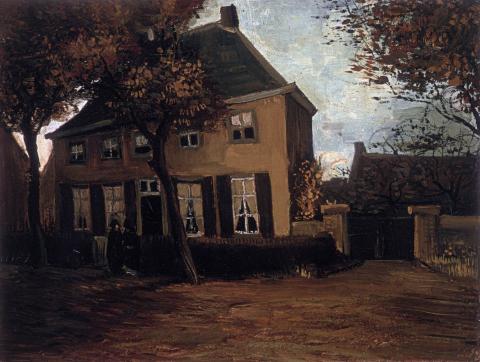-
Table of Contents
- 0. STORY PREFACE
- 1. EARLY LIFE
- 2. AN ARTIST IS BORN
- 3. STUDYING ART, FEELING PAIN
- 4. THE FIRST MASTERPIECE
- 5. THE PARIS YEARS
- 6. INFLUENCE of JAPANESE ART
- 7. EARLY LIFE in ARLES
- 8. THE BANDAGED EAR
- 9. VINCENT at SAINT-REMY
- 10. THE ATTACKS CONTINUE
- 11. PAINTING in AUVERS-sur-OISE
- 12. WORRIES and TURMOIL
- 13. VINCENT COMMITS SUICIDE
- 14. THE SADNESS WILL LAST FOREVER
Vincent painted “The Vicarage at Nuenen,” where his parents were living in 1885, between the months of September and October that year. The original is now owned by the van Gogh Museum in Amsterdam. Nuenen is located in the south-central area of The Netherlands.
To study art, van Gogh moved to Brussels where he was financially supported by his father and younger brother Theo. But Vincent didn't really like formal training in an academic setting, and scholars dispute whether he was actually accepted by the Ecole des Beaux-Art in Brussels.
He made progress on his own, however, as he studied - and copied - works by his favorite artist, Jean-François Millet, such as The Sower and Angelus.
Before getting too far ahead of himself, Vincent also studied the basics. Charles Bargue, a Frenchman, had designed courses which Vincent ferociously practiced. He told Theo that Exercises au fusain (how to use your pencil) and Cours de dessin (the drawing course, republished in 2003) were especially helpful.
Only a few of his drawings from this time period survive.
Brussels, in 1881, was an expensive place to live. Vincent decided that he would spend the summer with his parents in the Dutch town of Etten. There was, after all, "a lot to draw there." He would concentrate, especially, on landscapes and villagers.
One area of concentration, however, was completely misplaced. While in Etten, van Gogh fell in love.
His cousin "Kee" (Cornelia Vos-Stricker) had lost her husband and was raising their son on her own. Vincent thought they'd make a great match. Kee disagreed. The more he tried to change her mind, the more upset Kee became. When he proposed marriage, Kee rebuffed Vincent with words he never forgot:
Never, no, never.
At about the time of this unwelcome event, Vincent received an unexpected present from another cousin (by marriage). Anton Mauve, a successful artist, gave Vincent his first set of watercolors.
Working in The Hague, van Gogh experimented with this gift. By 1882, still depending on his brother Theo for financial support, he was also working with oil paints.
Returning to his parents' home - they had since moved to the Dutch town of Nuenen - Vincent continued to improve his skills during late 1883 and throughout the following year. He would soon create what most scholars consider his first significant painting.
-
Table of Contents
- 0. STORY PREFACE
- 1. EARLY LIFE
- 2. AN ARTIST IS BORN
- 3. STUDYING ART, FEELING PAIN
- 4. THE FIRST MASTERPIECE
- 5. THE PARIS YEARS
- 6. INFLUENCE of JAPANESE ART
- 7. EARLY LIFE in ARLES
- 8. THE BANDAGED EAR
- 9. VINCENT at SAINT-REMY
- 10. THE ATTACKS CONTINUE
- 11. PAINTING in AUVERS-sur-OISE
- 12. WORRIES and TURMOIL
- 13. VINCENT COMMITS SUICIDE
- 14. THE SADNESS WILL LAST FOREVER


 Back
Back
 Next Chapter
Next Chapter

 Back
Back
 Next Chapter
Next Chapter


